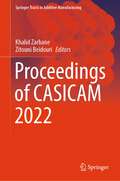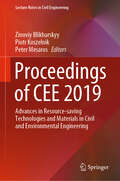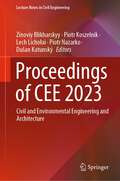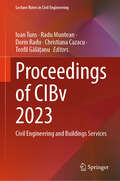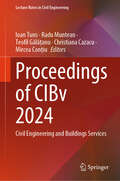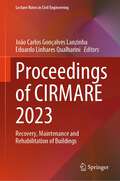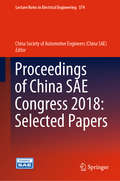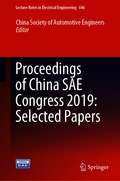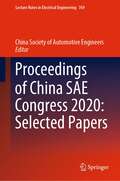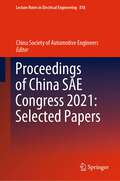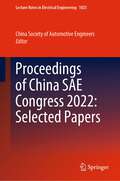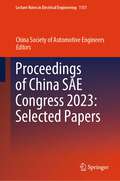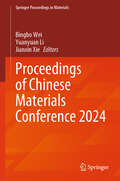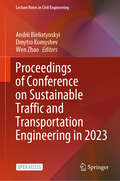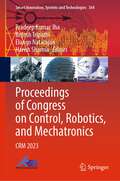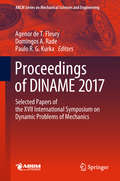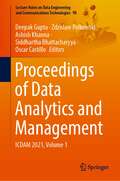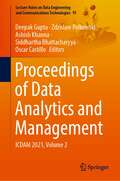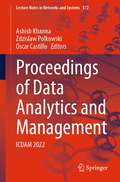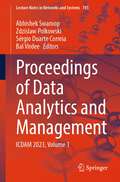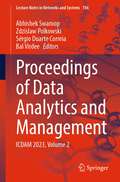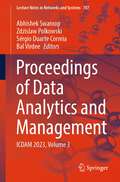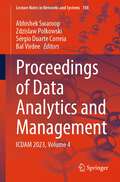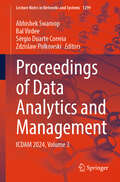- Table View
- List View
Proceedings of CASICAM 2022 (Springer Tracts in Additive Manufacturing)
by Khalid Zarbane Zitouni BeidouriThis book contains selected papers from the conference CASICAM'22, presenting the latest advancements and discoveries in Additive Manufacturing (AM) technology. The chapters cover a wide range of topics related to AM, including design for additive manufacturing, functionally graded additive manufacturing (FGAM), new and innovative materials for AM, AM parts/processes modeling and simulation, AM process optimization, monitoring, and qualification, 4D printing, AM post-processing operations, AM product metrology and quality control, AM standards and certification, health, safety, and environment challenges, education, training, and research strategy, and AM applications and challenges.
Proceedings of CEE 2019: Advances in Resource-saving Technologies and Materials in Civil and Environmental Engineering (Lecture Notes in Civil Engineering #47)
by Zinoviy Blikharskyy Piotr Koszelnik Peter MesarosThis book gathers the latest advances, innovations, and applications in the field of effective methods of calculation, resource-saving technologies and advanced materials in civil and environmental engineering, as presented by leading international researchers and engineers at the XVII International Scientific Conference Current Issues of Civil and Environmental Engineering “Lviv- Košice – Rzeszów”, held in Lviv, Ukraine on September 11-13, 2019. It covers highly diverse topics, including structural shaping and optimization; aspects of structural behavior and modeling; advanced analysis methods; experimental tests and numerical simulations; design codes, in particular Eurocodes and other national and regional limit state codes; and highway and bridges engineering. It also discusses modern architectural and structural solutions; innovative materials and products; durability and maintenance; fabrication and erection; sustainability in construction; renewable energy sources; heat, gas and water supply; ventilation and air-conditioning; ecological and energy-saving technologies, modern water-purification and treatment technologies; and the protection of water ecosystems. The contributions, which were selected by means of a rigorous international peer-review process, highlight numerous exciting ideas that will spur novel research directions and foster multidisciplinary collaborations.
Proceedings of CEE 2023: Civil and Environmental Engineering and Architecture (Lecture Notes in Civil Engineering #438)
by Zinoviy Blikharskyy Piotr Koszelnik Dušan Katunský Lech Lichołai Piotr NazarkoThis book gathers the latest advances, innovations, and applications in the field of effective methods of calculation, resource-saving technologies, and advanced materials in civil and environmental engineering, as presented by leading international researchers and engineers at the XVIII International Scientific Conference Current Issues of Civil and Environmental Engineering “Lviv- Košice – Rzeszów”, held in Rzeszów, Poland, on September 6–8, 2023. It covers highly diverse topics, including structural shaping and optimization; aspects of structural behavior and modeling; advanced analysis methods; experimental tests and numerical simulations; design codes, in particular Eurocodes and other national and regional limit state codes; and highway and bridges engineering. It also discusses modern architectural and structural solutions; innovative materials and products; durability and maintenance; fabrication and erection; sustainability in construction; renewable energy sources; heat, gas, and water supply; ventilation and air-conditioning; ecological and energy-saving technologies, modern water purification, and treatment technologies; and the protection of water ecosystems. This book, which was selected by means of a rigorous international peer-review process, highlights numerous exciting ideas that will spur novel research directions and foster multidisciplinary collaborations.
Proceedings of CIBv 2023: Civil Engineering and Buildings Services (Lecture Notes in Civil Engineering #510)
by Ioan Tuns Radu Muntean Dorin Radu Christiana Cazacu Teofil GălățanuThis book gathers the proceedings of the 18th International Conference on Civil Engineering and Buildings Services (CIBv), held in Brașov, Romania on November 2-3, 2023. It covers highly diverse topics such as structural analysis and optimization, concrete, steel and timber structures, computer aided design of structures, railways, roads and bridges, geotechnics and foundations, experimental methods in the investigation of structures, new and improved building materials, risk assessment of natural hazards, advanced energy design for HVAC installations, energy performance of buildings, and efficient buildings. Written by leading researchers and engineers, and selected by means of a rigorous international peer-review process, the contributions highlight numerous exciting ideas that will spur novel research directions and foster multidisciplinary collaborations.
Proceedings of CIBv 2024: Civil Engineering and Buildings Services (Lecture Notes in Civil Engineering #665)
by Ioan Tuns Radu Muntean Christiana Cazacu Teofil Gălățanu Mircea ConțiuThis book gathers the proceedings of the 19th International Conference on Civil Engineering and Buildings Services (CIBv), held in Brașov, Romania, on November 7–8, 2024. It covers highly diverse topics such as structural analysis and optimization, concrete, steel and timber structures, computer aided design of structures, railways, roads and bridges, geotechnics and foundations, experimental methods in the investigation of structures, new and improved building materials, risk assessment of natural hazards, advanced energy design for HVAC installations, energy performance of buildings, and efficient buildings. Written by leading researchers and engineers, and selected by means of a rigorous international peer-review process, the contributions highlight numerous exciting ideas that will spur novel research directions and foster multidisciplinary collaborations.
Proceedings of CIRMARE 2023: Recovery, Maintenance and Rehabilitation of Buildings (Lecture Notes in Civil Engineering #444)
by João Carlos Gonçalves Lanzinha Eduardo Linhares QualhariniThis book highlights the latest advances, innovations, and applications in the field of resilience and adaptation of buildings and cities to climate change, as presented by international researchers at the VI International Conference on Recovery, Maintenance and Rehabilitation of Buildings (CIRMARE 2023), held in Covilhã, Portugal, on December 5–7, 2023. It covers a diverse range of topics such as accessibility of buildings and urban spaces, industrialization of rehabilitation processes, interventions in cultural heritage, building quality assessment, maintenance and requalification of built spaces, BIM and the digitization of construction, urban planning, circular economy in the construction sector, urban infrastructure rehabilitation, near zero energy buildings, urban resilience and climate change, recovery of degraded urban areas, service life, and pathologies in buildings. The contributions, which were selected by means of a rigorous international peer-review process, present a wealth of exciting ideas that will open novel research directions and foster multidisciplinary collaboration among different specialists.
Proceedings of China SAE Congress 2018: Selected Papers (Lecture Notes in Electrical Engineering #574)
by China Society of Automotive EngineersThis Proceedings volume gathers outstanding papers submitted to Proceedings of China SAE Congress 2018: Selected Papers, the majority of which are from China – the largest car-maker as well as most dynamic car market in the world. The book covers a wide range of automotive topics, presenting the latest technical advances and approaches to help technicians solve the practical problems that most affect their daily work.It is intended for researchers, engineers and postgraduate students in the fields of automotive engineering and related areas.
Proceedings of China SAE Congress 2019: Selected Papers (Lecture Notes in Electrical Engineering #646)
by China Society of Automotive EngineersThese proceedings gather outstanding papers presented at the China SAE Congress 2019. Featuring contributions mainly from China, the biggest carmaker as well as most dynamic car market in the world, the book covers a wide range of automotive topics and the latest technical advances in the industry. Many of the approaches included can help technicians to solve practical problems that affect their daily work. In addition, the book offers valuable technical support to engineers, researchers and postgraduate students in the field of automotive engineering.
Proceedings of China SAE Congress 2020: Selected Papers (Lecture Notes in Electrical Engineering #769)
by China Society of Automotive EngineersThese proceedings gather outstanding papers presented at the China SAE Congress 2020, held on Oct. 27-29, Shanghai, China. Featuring contributions mainly from China, the biggest carmaker as well as most dynamic car market in the world, the book covers a wide range of automotive-related topics and the latest technical advances in the industry. Many of the approaches in the book will help technicians to solve practical problems that affect their daily work. In addition, the book offers valuable technical support to engineers, researchers and postgraduate students in the field of automotive engineering.
Proceedings of China SAE Congress 2021: Selected Papers (Lecture Notes in Electrical Engineering #818)
by China Society of Automotive EngineersThese proceedings gather outstanding papers presented at the China SAE Congress 2021, held on Oct. 19-21, Shanghai, China. Featuring contributions mainly from China, the biggest carmaker as well as most dynamic car market in the world, the book covers a wide range of automotive-related topics and the latest technical advances in the industry. Many of the approaches in the book will help technicians to solve practical problems that affect their daily work. In addition, the book offers valuable technical support to engineers, researchers and postgraduate students in the field of automotive engineering.
Proceedings of China SAE Congress 2022: Selected Papers (Lecture Notes in Electrical Engineering #1025)
by China Society of Automotive EngineersThis book gathers outstanding papers presented at the China SAE Congress 2022, featuring contributions mainly from China, the biggest carmaker as well as most dynamic car market in the world. The book covers a wide range of automotive-related topics and the latest technical advances in the industry. Many of the approaches in the book help technicians to solve practical problems that affect their daily work. In addition, the book offers valuable technical support to engineers, researchers, and postgraduate students in the field of automotive engineering.
Proceedings of China SAE Congress 2023: Selected Papers (Lecture Notes in Electrical Engineering #1151)
by China Society of Automotive EngineersThis book gathers outstanding papers presented at the China SAE Congress 2023, featuring contributions mainly from China, the biggest carmaker as well as most dynamic car market in the world. The book covers a wide range of automotive-related topics and the latest technical advances in the industry. Many of the approaches in the book help technicians to solve practical problems that affect their daily work. In addition, the book offers valuable technical support to engineers, researchers, and postgraduate students in the field of automotive engineering.
Proceedings of Chinese Materials Conference 2024 (Springer Proceedings in Materials #66)
by Bingbo Wei Yuanyuan Li Jianxin XieThis book is the conference proceedings of the Chinese Materials Conference 2024 held by the Chinese Materials Research Society (C-MRS) in Guangzhou, China. It consists of about 20 papers in fields such as energy materials, environmental materials, advanced structural materials, functional materials as well as materials simulation, preparation and evaluation. Readers will encounter new ideas and technologies in the field of advanced materials.
Proceedings of Conference on Sustainable Traffic and Transportation Engineering in 2023 (Lecture Notes in Civil Engineering #603)
by Andrii Bieliatynskyi Dmytro Komyshev Wen ZhaoThis open access book discusses modern cutting-edge techniques and theoretical research in the domain of transportation engineering. As China's Belt and Road Initiative (BRI) gains momentum over these years, the construction of transport routes between China and its neighboring countries has seen an unprecedented rise, which draws increased attention from researchers to the theoretical advances and technological innovation in the construction of transportation facilities. It will be an invaluable asset for the development of transport infrastructure construction technologies worldwide. Among the landmark engineering projects in the initiative are the Piraeus Port in Greece, the 100-MW photovoltaic power plant in Hungary-Kauposberg, and the Monnet Railway in Kenya, each of which stands out with its innovative highlights in theoretical research and technological advances. The book is expected to share with global experts and engineers in the field of transportation advanced research results and technologies in construction from China, discuss new research topics and explore feasible solutions in the realm of transportation engineering. The main topics discussed in this book include: a. New theories and technologies for the construction of roads, railroads, subways, airports, bridges, tunnels and other infrastructure; b. Advanced theories and technologies for the construction of ports, dams, reservoirs, sluices, hydraulic tunnels, canals and other infrastructure; c. Novel materials and innovative application of these materials to the construction of transportation facilities. This book is intended for graduate and doctoral students, experts and engineers in the field of transportation engineering.
Proceedings of Congress on Control, Robotics, and Mechatronics: CRM 2023 (Smart Innovation, Systems and Technologies #364)
by Harish Sharma Elango Natarajan Pradeep Kumar Jha Brijesh TripathiThis book features high-quality research papers presented at the International Conference of Mechanical and Robotic Engineering “Congress on Control, Robotics, and Mechatronics” (CRM 2023), jointly organized by Modi Institute of Technology, Kota, India, and Soft Computing Research Society, India, during 25–26 March 2023. This book discusses the topics such as combustion and fuels, controls and dynamics, fluid mechanics, I.C. engines and automobile engineering, machine design, mechatronics, rotor dynamics, solid mechanics, thermodynamics and combustion engineering, composite material, aerodynamics, aerial vehicles, missiles and robots, automatic design and manufacturing, artificial intelligence, unmanned aerial vehicles, autonomous robotic vehicles, evolutionary robotics, humanoids, hardware architecture, industrial robotics, intelligent control systems, microsensors and actuators, multi-robots systems, neural decoding algorithms, neural networks for mobile robots, space robotics, control theory and applications, model predictive control, variable structure control, and decentralized control.
Proceedings of DINAME 2017: Selected Papers of the XVII International Symposium on Dynamic Problems of Mechanics (Lecture Notes in Mechanical Engineering)
by Agenor De Fleury Domingos A. Rade Paulo R. KurkaThis book presents the most significant contributions to the DINAME 2017 conference, covering a range of dynamic problems to provide insights into recent trends and advances in a broad variety of fields seldom found in other proceedings volumes.DINAME has been held every two years since 1986 and is internationally recognized as a central forum for discussing scientific achievements related to dynamic problems in mechanics. Unlike many other conferences, it employs a single-session format for the oral presentations of all papers, which limits the number of accepted papers to roughly 100 and makes the evaluation process extremely rigorous.The papers gathered here will be of interest to all researchers, graduate students and engineering professionals working in the fields of mechanical and mechatronics engineering and related areas around the globe.
Proceedings of Data Analytics and Management: ICDAM 2021, Volume 1 (Lecture Notes on Data Engineering and Communications Technologies #90)
by Oscar Castillo Siddhartha Bhattacharyya Deepak Gupta Ashish Khanna Zdzislaw PolkowskiThis book includes original unpublished contributions presented at the International Conference on Data Analytics and Management (ICDAM 2021), held at Jan Wyzykowski University, Poland, during June 2021. The book covers the topics in data analytics, data management, big data, computational intelligence, and communication networks. The book presents innovative work by leading academics, researchers, and experts from industry which is useful for young researchers and students.
Proceedings of Data Analytics and Management: ICDAM 2021, Volume 2 (Lecture Notes on Data Engineering and Communications Technologies #91)
by Oscar Castillo Siddhartha Bhattacharyya Deepak Gupta Ashish Khanna Zdzislaw PolkowskiThis book includes original unpublished contributions presented at the International Conference on Data Analytics and Management (ICDAM 2021), held at Jan Wyzykowski University, Poland, during June 2021. The book covers the topics in data analytics, data management, big data, computational intelligence, and communication networks. The book presents innovative work by leading academics, researchers, and experts from industry which is useful for young researchers and students.
Proceedings of Data Analytics and Management: ICDAM 2022 (Lecture Notes in Networks and Systems #572)
by Oscar Castillo Ashish Khanna Zdzislaw PolkowskiThis book includes original unpublished contributions presented at the International Conference on Data Analytics and Management (ICDAM 2022), held at tThe Karkonosze University of Applied Sciences, Poland, during June 2022. The book covers the topics in data analytics, data management, big data, computational intelligence, and communication networks. The book presents innovative work by leading academics, researchers, and experts from industry which is useful for young researchers and students.
Proceedings of Data Analytics and Management: ICDAM 2023, Volume 1 (Lecture Notes in Networks and Systems #785)
by Zdzislaw Polkowski Abhishek Swaroop Sérgio Duarte Correia Bal VirdeeThis book includes original unpublished contributions presented at the International Conference on Data Analytics and Management (ICDAM 2023), held at London Metropolitan University, London, UK, during June 2023. The book covers the topics in data analytics, data management, big data, computational intelligence, and communication networks. The book presents innovative work by leading academics, researchers, and experts from industry which is useful for young researchers and students. The book is divided into four volumes.
Proceedings of Data Analytics and Management: ICDAM 2023, Volume 2 (Lecture Notes in Networks and Systems #786)
by Zdzislaw Polkowski Abhishek Swaroop Sérgio Duarte Correia Bal VirdeeThis book includes original unpublished contributions presented at the International Conference on Data Analytics and Management (ICDAM 2023), held at London Metropolitan University, London, UK, during June 2023. The book covers the topics in data analytics, data management, big data, computational intelligence, and communication networks. The book presents innovative work by leading academics, researchers, and experts from industry which is useful for young researchers and students. The book is divided into four volumes.
Proceedings of Data Analytics and Management: ICDAM 2023, Volume 3 (Lecture Notes in Networks and Systems #787)
by Zdzislaw Polkowski Abhishek Swaroop Sérgio Duarte Correia Bal VirdeeThis book includes original unpublished contributions presented at the International Conference on Data Analytics and Management (ICDAM 2023), held at London Metropolitan University, London, UK, during June 2023. The book covers the topics in data analytics, data management, big data, computational intelligence, and communication networks. The book presents innovative work by leading academics, researchers, and experts from industry which is useful for young researchers and students. The book is divided into four volumes.
Proceedings of Data Analytics and Management: ICDAM 2023, Volume 4 (Lecture Notes in Networks and Systems #788)
by Zdzislaw Polkowski Abhishek Swaroop Sérgio Duarte Correia Bal VirdeeThis book includes original unpublished contributions presented at the International Conference on Data Analytics and Management (ICDAM 2023), held at London Metropolitan University, London, UK, during June 2023. The book covers the topics in data analytics, data management, big data, computational intelligence, and communication networks. The book presents innovative work by leading academics, researchers, and experts from industry which is useful for young researchers and students. The book is divided into four volumes.
Proceedings of Data Analytics and Management: ICDAM 2024, Volume 3 (Lecture Notes in Networks and Systems #1299)
by Zdzislaw Polkowski Abhishek Swaroop Sérgio Duarte Correia Bal VirdeeThis book includes original unpublished contributions presented at the International Conference on Data Analytics and Management (ICDAM 2024), held at London Metropolitan University, London, UK, during June 2024. The book covers the topics in data analytics, data management, big data, computational intelligence, and communication networks. The book presents innovative work by leading academics, researchers, and experts from industry which is useful for young researchers and students. The book is divided into six volumes.
Proceedings of Data Analytics and Management: ICDAM 2024, Volume 5 (Lecture Notes in Networks and Systems #1301)
by Zdzislaw Polkowski Abhishek Swaroop Sérgio Duarte Correia Bal VirdeeThis book includes original unpublished contributions presented at the International Conference on Data Analytics and Management (ICDAM 2024), held at London Metropolitan University, London, UK, during June 2024. The book covers the topics in data analytics, data management, big data, computational intelligence, and communication networks. The book presents innovative work by leading academics, researchers, and experts from industry which is useful for young researchers and students. The book is divided into six volumes.
